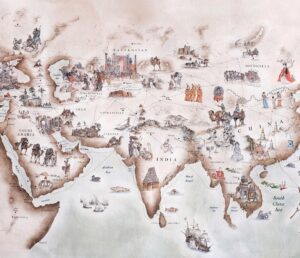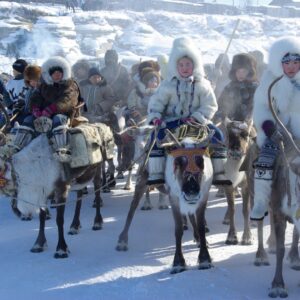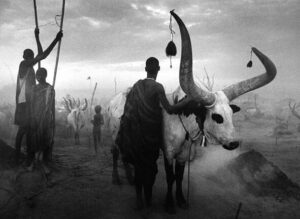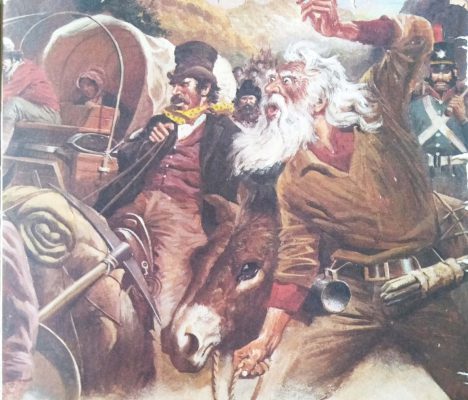 Pin
Pin A WILD-EYED man waving a bottle of gold dust raced down the main street of the tiny town of San Francisco, shouting as he ran: ‘‘Gold! Gold! Gold from the American River!’’
It was May 15, 1848, and soon there was madness in the air, madness that grew and grew as gold fever raged. One of those who lived through the insanity later recalled: ‘‘All went off to the mines, some On carts, some on horses, and some on crutches, and one went in a litter.’’
It was the start of the greatest gold rush of all, one that was to set California on its rocket-like rise to fabulous prosperity and to trigger off America’s rise to world power. Yet because news — and people —travelled slowly in those days, it was not until 1849 that the world-wide stampede to California began. The Forty-Niners were on their way…
There had been a few small gold strikes before 1848, but none to match the historic one on January 24, 1848. It happened while a saw mill was being built on land belonging to a rich businessman, John Sutter, who had come to America from Switzerland. James Marshall, his head carpenter, was in charge of the work, which was taking place on the south fork of the American River, some way from Sutter’s Fort, as Sutter’s home was grandly called. Marshall made his , find in the tail race — the water below the wheel.
“There upon the rock, about six inches beneath the surface of the water, I DISCOVERED THE GOLD. I was entirely alone at the time,’’ he later recalled.
His discovery came at a fateful moment. The USA and Mexico had been at war, and the find came just a week before America Officially gained California from Mexico at the peace treaty, the Americans having no conception of their luck.
Sutter swore his employees to secrecy, but it was useless. First rumours circulated, then came the dash down the San Francisco street. The sprinter was a shrewd merchant named Sam Brannan who had stumbled on a talkative Sutter man.
 Pin
Pin Californians of Spanish descent were not so gold crazy as the local Americans. There were some 14,000 whites in all and only 1,000 took part in the very first rush, nearly all of them Americans. The rush became more and more frantic when lumps of more than 10 kilos were discovered.
Gradually, the news spread round the world. A pattern was set that kept repeating itself for half a century in America, Australia, New Zealand and South Africa. As soon as news of a gold strike broke, entire ships’ crews deserted and raced to the goldfields. Office boys and others all over America, Britain and elsewhere left their work and raced for the docks. Everyone from model citizens to killers hit the trail. The vast majority would find little or no gold, but a very few would make huge fortunes.
Getting to California was hard. Some made long sea journeys from Hawaii, Australia, eastern America and Europe — Americans and Europeans having to round Cape Horn as there was then no Panama Canal. Sea voyages were usually safe but slow: other routes were anything but not safe.
Thousands headed West across the Plains and the Rockies, many dying from disease, exhaustion, hunger and thirst, while some were killed by Indians. Few had any idea what crossing the American continent involved.
Others risked short cuts across Panama and Nicaragua through dense, steaming, fever-ridden jungles, and many died. The majority of those on every route were woefully ill-equipped, not only for long journeys but for the rugged life of a prospector.
Yet that first gold rush summer of 1848 before the hordes arrived was something of a paradise. There was little crime and a lot of gold. Under a blazing sun men panned for gold beside or in ice-cold streams. Others found it in crevices of rock, in the earth, or lying around.
However, few made real fortunes and some of those that did lost them in gambling sprees.
Sutter suffered from squatters invading his land and died before the Government got around to compensating him, while Marshall, the original finder, was not given a reward — a small pension — until the 1870s. A statue, was erected to him by a grateful California after his death.
Those who made the most money were traders and businessmen who supplied goods to miners. One of them, an Italian named Ghiradelli, sold sweets and chocolates to miners and ended up a millionaire.
The biggest year of all was 1852 when 81 million dollars’ worth of gold was found. San Francisco, whose population was 800 in 1848, was now a boom town, for it was where the money went. Crime was often rampant and had to be put down by vigilante groups. By the end of the century the total amount of gold found in California exceeded the 1,000 million dollars mark.
The losers in all this were the local Indians. There had been 100,000 of them in 1849 in California but, by 1860, there were only some 30,000 left. Few were warlike, unlike the warriors of the plains, and they were killed by violence, disease or overwork. As far as the miners were concerned, they were ‘in the way’.
By 1900, mining in California had become very scientific. The easy pickings were gone and much of it happened to be deep underground.
There were always some miners to be seen panning (the pan is still used to this day) but other tools appeared in the 1850s, most of them improvements on the pan: the cradle (or rocker), the long tom and the sluice. Great jets of water were used to blast hillsides into giving up gold-bearing matter. Yet the pan had one unique advantage. It was the only way of preventing the smallest particles of gold from disappearing.
As for the miners, most of them drifted away after their great adventure, but a hard core remained who sought gold all their life, and silver as well. Some of those who went to California in 1849 were to be found heading northwards on the Klondike Stampede in 1898, having taken in a dozen other rushes in between.
They did not think of themselves as having made history, but they had. Not only had gold made California and the nation prosper hugely, it had speeded up the process of westward expansion. In 1848, the United States virtually ended at the Mississippi, despite the few thousand pioneers who had reached Oregon and those who had gone to Texas. After 1848, the nation would soon truly stretch from sea to sea.
 Pin
Pin The Cradle: This was a wooden box on rockers. At its lower end, which was open, were bars called riffles. In its upper end, a canvas ‘apron’ was placed at an angle. Fixed on top of this was a ‘hopper’ which had a perforated base end a handle. Gravel thought to contain gold was placed in the hopper, water was then poured over and the cradle was rocked with the handle. The water strained through, was deflected by the apron and gold particies, which were heavier than the rest of the gravel, were left behind the riffles.
 Pin
Pin The Long Tom: This had two parts — a fairly long inclined trough ending in an iron riddle and a riffle box on which the trough rested. Dirt was washed down the trough, through the riddle and into the riffle box, where gold particles caught in the bars.
 Pin
Pin 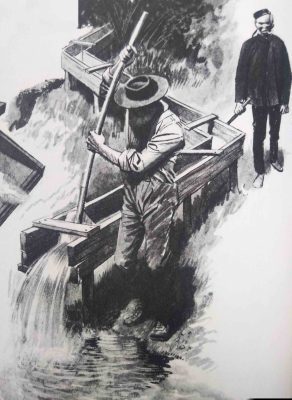 Pin
Pin The Sluice: This was an extended long tom. A number of riffle boxes were fitted together in a long trough, water flowed through and miners pushed the pay dirt along it. More pay dirt could be processed by the sluice than the long tom because of its much greater length.
Who were The Forty-Niners?
The Forty-Niners, also known as the California Gold Rush pioneers, were the thousands of people who migrated to California in search of gold during the prevalent Gold Rush in the mid-1800s. This mass movement occurred after gold was discovered at Sutter’s Mill on January 24, 1848, by James W. Marshall.
Initially, news about the discovery of gold spread slowly throughout California and the rest of the United States, but as the truth became evident, a frenzy ignited. People from all walks of life were enticed by the prospect of striking it rich, abandoning their jobs, families, and homes to embark on a perilous journey to the West Coast. These pioneers came from various regions within the United States, as well as from different parts of the world, including Europe, Asia, and Latin America.
The term “Forty-Niners” derived from the estimated arrival of these pioneers in California in the year 1849. Although some arrived earlier and others later, the name stuck and has since been associated with the brave individuals who sought their fortunes in the goldfields of California.
The journey to California was no easy feat for the Forty-Niners. Most took arduous routes, such as the Oregon and California Trails, to reach their final destination. These trails, often with treacherous terrain, involved crossing vast plains, deserts, and treacherous mountains. The passage was marked by dangerous river crossings, harsh weather conditions, and the constant threat of disease and attacks from Native American tribes.
Upon arrival in California, the Forty-Niners faced further challenges. Many found themselves in overcrowded and lawless mining camps spread across the Sierra Nevada foothills. These camps, hastily constructed tent cities, lacked infrastructure and basic amenities, such as clean water, sanitation systems, and law enforcement. Living conditions were harsh, and diseases like dysentery, malaria, and cholera were rampant.
Despite the difficulties they faced, the Forty-Niners demonstrated incredible resilience and resourcefulness. They built makeshift homes and communities from scratch, establishing mining towns that sprang up almost overnight. These towns became the epicenter of gold mining activities, with merchants, saloons, and other businesses catering to the needs and desires of the miners. As the population grew, more permanent structures were developed, transforming the camps into bustling towns and cities.
Gold mining was physically demanding work, requiring miners to dig and sift through rocks and sediment in search of gold. Many used simple tools such as picks, shovels, and pans, while others employed more complex techniques such as hydraulic mining or using sluice boxes.
The work was hard and often dangerous, with cave-ins and accidents occurring frequently. While a few fortunate individuals struck it rich and became overnight millionaires, the majority of Forty-Niners struggled to find significant amounts of gold. The competition was fierce, and the areas where gold could be extracted were quickly depleted. As a result, miners turned to other forms of work, such as farming, ranching, and starting businesses to sustain themselves.
The California Gold Rush fundamentally changed the landscape and society of California. Towns and cities grew rapidly, and the population expanded exponentially. The influx of people from diverse backgrounds brought cultural and societal changes, with the development of a multicultural and cosmopolitan society. The economic impact was significant, providing a major boost to California’s economy and contributing to the eventual statehood of California.
The story of the Forty-Niners is one of determination, risk-taking, and resilience. These pioneers took a chance, leaving behind their familiar lives in search of a golden dream. While not all achieved the riches they sought, their courage and spirit shaped the history of California and left an enduring legacy as the iconic symbol of the California Gold Rush.
The primary motivations that drove individuals to join the California Gold Rush and become Forty-Niners were:
Overall, the primary motivations that drove individuals to join the California Gold Rush and become Forty-Niners were the hopes of attaining wealth, escaping poverty or debt, seeking adventure, taking part in a historic event, finding a better life, and seeking new opportunities.
The presence of the Forty-Niners, referring to the individuals who rushed to California in search of gold during the mid-19th century, had a significant impact on the social, economic, and cultural landscape of the state.
The presence of the Forty-Niners during the mid-19th century transformed California socially, economically, and culturally. The rapid growth, multiculturalism, economic boom, and cultural diversity that resulted from the Gold Rush laid the foundation for California’s development and shaped its identity as we know it today.
There were several factors that contributed to the rapid growth of the Forty-Niner population in California during the Gold Rush:
Overall, the rapid growth of the Forty-Niner population in California during the Gold Rush was driven by the discovery of gold, economic opportunities, global migration, transportation advancements, government support, and technological innovations.
Frequently Asked Questions : The Forty-Niners
The Forty-Niners were the name given to the people who migrated to California in 1849 during the California Gold Rush. These individuals were seeking fortune and wealth by mining for gold.
The California Gold Rush started in 1848 when gold was discovered at Sutter’s Mill by James W. Marshall. News of the discovery quickly spread, attracting thousands of people from all over the world to come to California in search of gold.
The term “Forty-Niners” refers to the year 1849 when the majority of gold prospectors arrived in California. They were called Forty-Niners because they arrived during that particular year.
The Forty-Niners came from various parts of the world, including the United States, Europe, China, Australia, and Latin America. People from all walks of life and from different socioeconomic backgrounds were drawn to California in search of wealth.
Many Forty-Niners traveled by land, using wagons, horses, or on foot. They faced numerous challenges, such as crossing treacherous rivers, traversing rough terrain, and dealing with adverse weather conditions. Others traveled by sea, either on ships or by taking long and arduous journeys around Cape Horn in South America.
Life for the Forty-Niners was extremely tough and harsh. They faced extreme weather conditions, disease, and isolation. The work of gold mining was physically demanding, and many miners faced disappointment and failure in their quests for gold.
The treatment of Native Americans by the Forty-Niners varied. Some Native Americans were initially helpful and provided information on where to find gold, while others were pushed off their land, mistreated, or killed. The influx of miners resulted in conflicts and dispossession of Native American lands.
The arrival of the Forty-Niners caused a significant increase in California’s population. Prior to their arrival, California had a small population, but the Gold Rush brought in thousands of prospectors, which led to the growth of towns and the development of infrastructure in the region.
No, not all Forty-Niners struck it rich. While some individuals did find significant amounts of gold, the majority faced disappointment and struggled to make a living. The competition for gold was intense, and only a small percentage of miners actually succeeded in finding substantial amounts.
The activities of the Forty-Niners had a significant impact on the environment. They used hydraulic mining techniques that resulted in environmental degradation, such as erosion, deforestation, and water pollution. The destruction caused by these mining methods had long-lasting effects on California’s ecosystems.
The legacy of the Forty-Niners is one of ambition, adventure, and the pursuit of the American Dream. The California Gold Rush played a crucial role in the development and settlement of the American West. It also had an impact on American history, as it stimulated westward migration and contributed to the growth of California as a state. The myth and allure of the Forty-Niners remains embedded in American culture.


















